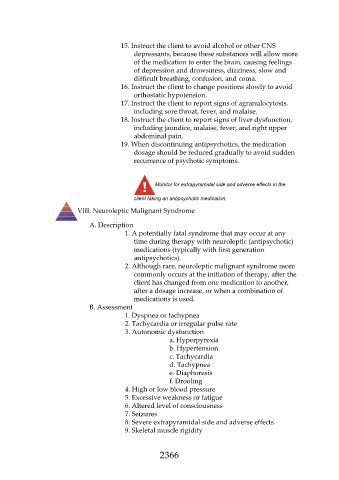Page 2366 - Saunders Comprehensive Review For NCLEX-RN
P. 2366
15. Instruct the client to avoid alcohol or other CNS
depressants, because these substances will allow more
of the medication to enter the brain, causing feelings
of depression and drowsiness, dizziness, slow and
difficult breathing, confusion, and coma.
16. Instruct the client to change positions slowly to avoid
orthostatic hypotension.
17. Instruct the client to report signs of agranulocytosis,
including sore throat, fever, and malaise.
18. Instruct the client to report signs of liver dysfunction,
including jaundice, malaise, fever, and right upper
abdominal pain.
19. When discontinuing antipsychotics, the medication
dosage should be reduced gradually to avoid sudden
recurrence of psychotic symptoms.
Monitor for extrapyramidal side and adverse effects in the
client taking an antipsychotic medication.
VIII. Neuroleptic Malignant Syndrome
A. Description
1. A potentially fatal syndrome that may occur at any
time during therapy with neuroleptic (antipsychotic)
medications (typically with first generation
antipsychotics).
2. Although rare, neuroleptic malignant syndrome more
commonly occurs at the initiation of therapy, after the
client has changed from one medication to another,
after a dosage increase, or when a combination of
medications is used.
B. Assessment
1. Dyspnea or tachypnea
2. Tachycardia or irregular pulse rate
3. Autonomic dysfunction
a. Hyperpyrexia
b. Hypertension
c. Tachycardia
d. Tachypnea
e. Diaphoresis
f. Drooling
4. High or low blood pressure
5. Excessive weakness or fatigue
6. Altered level of consciousness
7. Seizures
8. Severe extrapyramidal side and adverse effects
9. Skeletal muscle rigidity
2366

